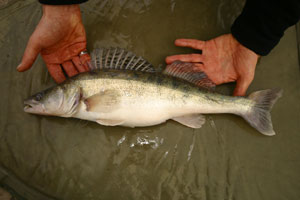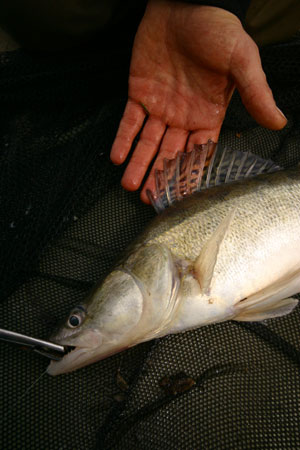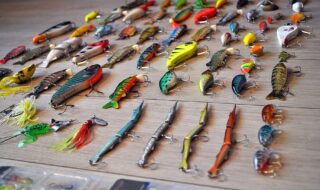Zander (Stizostedion lucioperca)
Weight: Fish between 1lb to 3lb hunt in shoals, but once they mature they tend to become solitary. The average size attained by most fish in the UK is 8lb, with zander over 12lb a rarity. But occasionally a fish over 15lb turns up.
Length: On average fish grow to between 66cm and 100cm. However, fish have been caught measuring 130cm.
Age: Can live for up to 15 years in the wild.
Preferred habitat: Zander are lovers of lowland rivers, drains, canals and large stillwaters and although they can live in depths of up to 30 metres, they prefer shallow, slow-flowing and turbid conditions.
Feeding: The zander is a carnivore and feeds on other fish, including its own kind, normally during dawn and dusk. They are most active during the summer.
Maturity: Both males and females mature in three to four years.
Spawning: This takes place between April and June, but with mild winters becoming the norm, some are known to spawn at the end of January. The sticky, pale yellow eggs are laid in a nest at the base of large aquatic roots or in beds of large gravel and are guarded by both parents during the five to 10 days they take to hatch.
Natural predators: Pike and zander
 |
Identification
Colouring
Greenish brown appearance with a number of dark, broken vertical bars that bleed from its back and down its flanks.
Mouth
A long, pointed snout with large jaws that house numerous small teeth, and some seriously razor-sharp fangs to grasp prey fish with.
Eyes
Two large eyes that have a reflective retina that enables the fish to stalk its prey in water with poor visibility and at night.
Pectoral Fins
These are almost colourless with black flecking. They are long and convex in shape with thick rays and rough edges.
Dorsal Fin
Two dorsal fins separated by a narrow gap, not unlike the perch, where the front fin is spiny and the rear is sail-shaped. Each of the fins is light brown in colour and the membrane between each ray in covered in dark spots.
Pelvic Fin
Like the pectorals, these fins are almost colourless, nearly see-through in fact. They are convex in shape with rough edges.
Anal Fin
This fin is located below the second dorsal fin. It is large and has a convex shape, with spines on the first two rays.
Tail/Caudal Fin
As you would expect, this predator has a large tail to enable it to power towards its prey from a standing start. It is concave in shape and has dark speckling close to the tips of each ray.
The Life Cycle
Did You Know?
Unusually amongst freshwater fish in Britain, both male and female zander protect their eggs for the 10-15 days they take to hatch.
How They Got Here
A native to central and Eastern Europe where it’s prized for its eating qualities, the zander became established in our natural waterways after 97 fish were introduced into the Great Ouse Relief Channel in Norfolk in 1967. The species had actually been in Britain for over 90 years, residing in ponds on the Woburn Estate in Bedfordshire. The Dukes of Bedford were responsible for bringing to Britain all manner of sporting species, including the Wels catfish.
Spreading Out
The fish spread naturally through the Fenland Drain system and into other East Anglian rivers like the Nene and Welland. Later they spread much further afield to the Severn, Trent and Thames and a number of notable stillwaters like Old Bury Hill and Coombe Abbey. They have now found their way into some of our big reservoirs, like Rutland, and seem to be doing very well there. Any stocking of zander now needs consent from the Environment Agency.
Spawning Time
Zander spawn in spring, typically April to June, when water temperatures go above 12ºC. The females produce up to 200,000 tiny eggs (around 1mm in diameter) for each kilogramme of their bodyweight, laid into a prepared (though rough) nest. This means a double-figure zander might lay over one million eggs each year! The young 5-6mm long fry feed initially on invertebrates, especially water fleas, though cannibalism is common amongst young zander. Big zander also enjoy eating small zander and this may be really important in control of their numbers when they appear in a new water.
Slow growers
Zander grow quite slowly when compared to pike. A one year-old zander might be around 10cm long, growing to 15cm after two years, 30cm after three years and 60cm after six to eight years. However, growth rates can be much faster in the warmer, southern parts of Europe. There they may grow as big as 20kg (1.3m long!) and live for perhaps as long as 20 years.
Eye Eye!
Zander are fantastically well adapted for life as a predator. They have a sleek body, capable of great acceleration through the water, and big teeth to grab and hold prey fish. But their best trick is the reflective lining to their eyes which means they can see in very low light levels and feed well from dusk through to dawn – not bad for an animal that hunts by sight. It follows that this is the best time to catch that big zander!
Bad Press
Zander seem to choose quite small prey fish, around 10-12% of their own length. Sometimes they hunt in packs and have been blamed for wrecking stocks of roach and bream after their introduction. The stocking of zander to East Anglia brought cries for a cull after stocks of silvers plummeted in the rivers and drains where zander appeared. However, the science behind this is not at all clear-cut. Some say that there were already serious problems in the relationship between pike and their roach and bream prey fish and the addition of zander simply tipped the balance the wrong way. Very often, it seems that even if stocks of roach and other silvers are affected by zander, given time they settle back into a new balance.






